Part 2 of the @uruiamme Introduction:
The development and success of the Motherboard HomeWorld, 1996 to 1999
This part is exciting because of how it ends. I must admit, though, the particulars of the story are interesting to me because this was the means by which I made money on the web. Your interest may be in how the advertising worked, the business aspects of the website, or the little tricks I employed to build the site.(I already posted this yesterday: Part 1: My Introduction and the value of content on the web. Please go back and check that one, too!)
[Part 3 is available, too!]
But in every story, there is something unique.
My story is about how computer motherboards, and specific knowledge of them, permitted me to build a following and a business based on something that I was an expert on. This happened on the nascent Web, starting in 1996 with this browser:
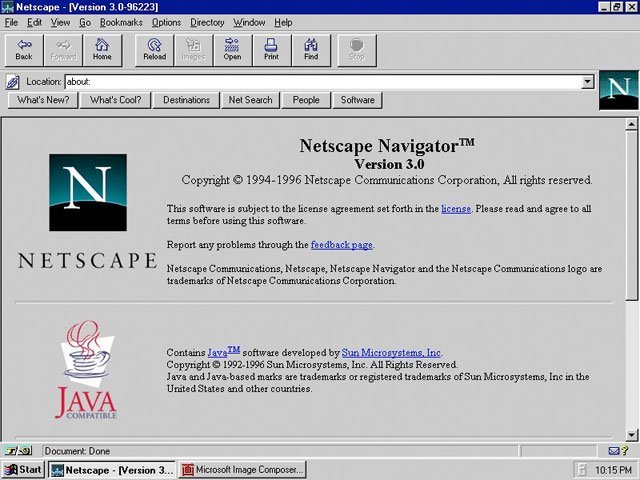
Netscape browser in 1996 on Windows 95
I used to tell people that I was an ad hoc Internet expert on motherboards. I had never designed one, I had no electrical engineering degree, and I neither sold them nor handled them. My expertise was based on what I gleaned from the Internet.
But that wasn’t enough.
I had to develop this into a platform to share my knowledge.
What good does my knowledge do unless I share it?
In effect I was not an expert on motherboards so much as I was a publisher of useful information about motherboards. I read countless spec sheets and then wrote articles on that. I visited numerous retail websites in hopes that I could find out what was common, what was cheap, and what was a specialized motherboard.It all started in the summer of 1996. I had just recently gotten released from the military, and I was back home looking for a good job in electronics. My resume at the time looked pretty good, and it was good enough to get me a good paying job soldering electronics.
I turned that job down.
The job I took, even though it paid considerably less, was a lot more interesting. I took a job maintaining PCs and telecom equipment for a large call center in an old Wal-Mart building. (It had been converted to two call centers and a data center because it had awesome connectivity.) PCs and telecom were very interesting fields to me, especially the PC part. I had already built my own computer 3 years prior to this job. Maintaining PCs sounded like a cool profession.
Geeks of the 90s
Back in the early 1990s, the geeks of the era would read and shop out of an enormous magazine called Computer Shopper. This was 5 pounds (2 kg) of advertisements mostly. The magazine was essentially purchased for the ads, because in those ads a geek could find virtually any computer component for cheap PC repairs. Or in my case, I ordered parts for an entire computer around 1994.So as I worked for this call center in 1996, I did troubleshooting on a lot of PCs during the day. At night, I wanted to get a modem and a subscription to the World Wide Web. I wanted to use the WWW to order a special motherboard. After all, the most important part of a PC is the motherboard.
Once on the web, my initial searches were not fruitful. The motherboard companies, as I will explain in Part 3, were not forthcoming with a lot of details about their products. I was seething.
Where are all the technical details of each motherboard?
Why can’t I just go to a motherboard manufacturer’s website and download a brochure?
This was just unacceptable to me. I essentially said in my wrath, I am going to start a web page about how to find a motherboard company!
Back in ancient times (1996), it was common for Internet Service Providers to offer a free web page for users. So I used my free web space to create my page. But rather than putting a picture of my dog on it or filling it with a description of my sports interests, I had a “Link Page” that soon morphed into a “Link Site” … I had three pages of content.
By the end of the fall, I had found my special motherboard and purchased it, and I had made one of the first independent websites out there on the Interwebs:
The Motherboard HomeWorld:
"The world's most dangerous Link Site"
More Links than the Law allows!
I was so proud
Here I am talking about it in a 1996 posting. In my own words:"So if you know of any other sites that are motherboard-related, I would like to know -- please e-mail me... I'm just trying to INFORM. This is my hobby and it's a service to people who want to compare motherboards on an apples-to-apples basis."
I promoted it ... using Spam techniques! In the fall of 1996, I posted a number of times to newsgroups. (Newsgroups are like e-mail forums.) Okay, I spammed about 30 of them. Interest grew, regardless of my bad netiquete. I bragged that I was using frames and even had my first advertiser.
Unbelievable! Really. One day, unexpectedly, money came knocking on the door.
A man (who represented a then-unheard of company) e-mailed me and then called me about setting up a paid banner advertisement. I couldn’t say no to that.
There I was, paying about $100 per year for dial-up Internet access, and this man was essentially willing to pay $100 for just 3 months of advertising.
I had no idea what I was doing, but somehow it worked in spite of my non-existent business acumen.
My first web advertisement: the monetization of my ideas in 1996

(Corsair advertisement, 1996 banner ad. This paid for my year's Internet!)
In the years since this happened 20 years ago, I can better explain it. In Part 4, I discuss the nature of web advertising in the 1990s.
I encountered a lot of behind-the-scenes difficulties with website maintenance. I took great care in keeping track of my page counters and traffic, impressing both my visitors and myself. But when the counters started to fail, and outages on my free website began to aggravate me, I switched to a different and more robust hosting company. It was a lot of turmoil to forward all of my visitors to the new URLs. These were the bad old days of the Web.
As the early part of 1997 wore on, I was constantly answering emails of visitors. I gave free advice to many. I would tweak things almost daily (or, I should say, nightly) to improve and add to the content. I wrote a massively important article on “How to Build a PC.” This content was going to be so massively crucial to my site’s success that I split it into sections. I have no idea how many thousands of people, all over the world, learned how to build a computer using my instructions.
I began to write some in-depth commentary on motherboards in general. The visitors to my site gobbled this up.
I even quit my day job
Yes, there I was one day. I had just promoted and developed my newly-minted, fresh website that I setup on the new server. It was around July 1997. I had been staying up late a lot, working on my site. And then, one day, the calls came in. I sat in my office at work one afternoon and landed ads on most of my website pages. Especially the home page. The hand was writing on the wall. July would be the first month that I made more money moonlighting as a website owner/operator than I did at my day job.I quit.
It was kind of surreal. I was living the dream... no place to go every morning at 8:00 am. No boss. No co-workers. I was entirely dependent on this virtual hosting website and the things I produced on my own. I had become a de facto content-writing professional.
What a strange way to enter into entrepreneurship! It happened so quickly ... without a business plan ... without a lawyer ... without a checking account. I'll never forget when I got checks in made payable to my website name... I didn't even register my website as a business name, so I had to have the companies rewrite the checks. I literally wrote them back kind letters asking to reprint the checks in my real name.
That was the wild, wild early days of the dot-com revolution. I lived them by the seat of my pajamas! 👘
When I promoted my website in 1997, I knew at the time that content was king. Here is a promotion I sent to advertisers around November 1997.
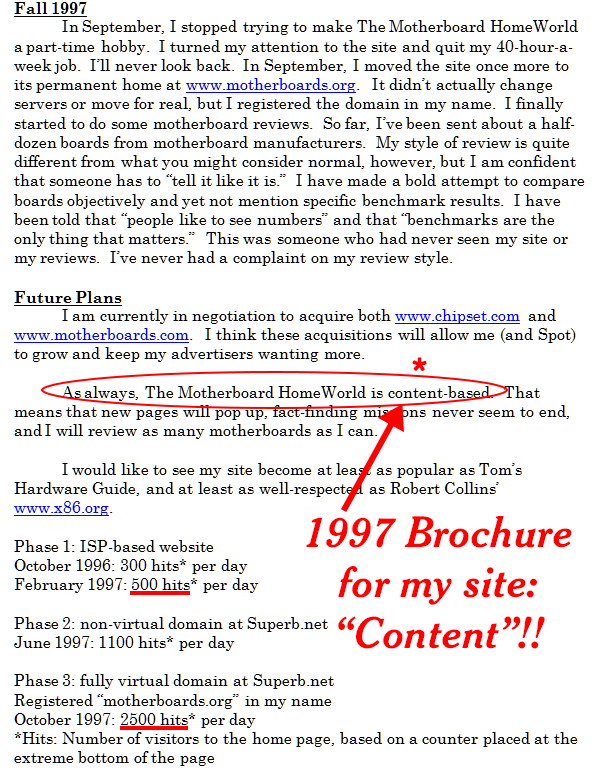
(Proof that Content was king even 20 years ago.)
The development of the site was always based on interesting content, keyword use, and (to some degree) getting inbound links. The "organic link" is usually the most valuable. This was true in my case.
I just checked my hard drive, and I still have some website stats for the Motherboard HomeWorld. Take a look at this list of incoming links. These are known as "referrers." In most cases web visitors find your website (and the valuable content they are looking for) by doing a global Internet search. In the 1990s, web pages numbered in the low millions, versus today when it is in the billions.
This represents referrers for the month of January 1999. The top external referrers are (1) the Award BIOS tech page and (2) the Alta Vista search engine. The Yahoo! Directory is fifth. It would be another month before the fledgling Google! search engine appeared in the Top 100 Referrers.
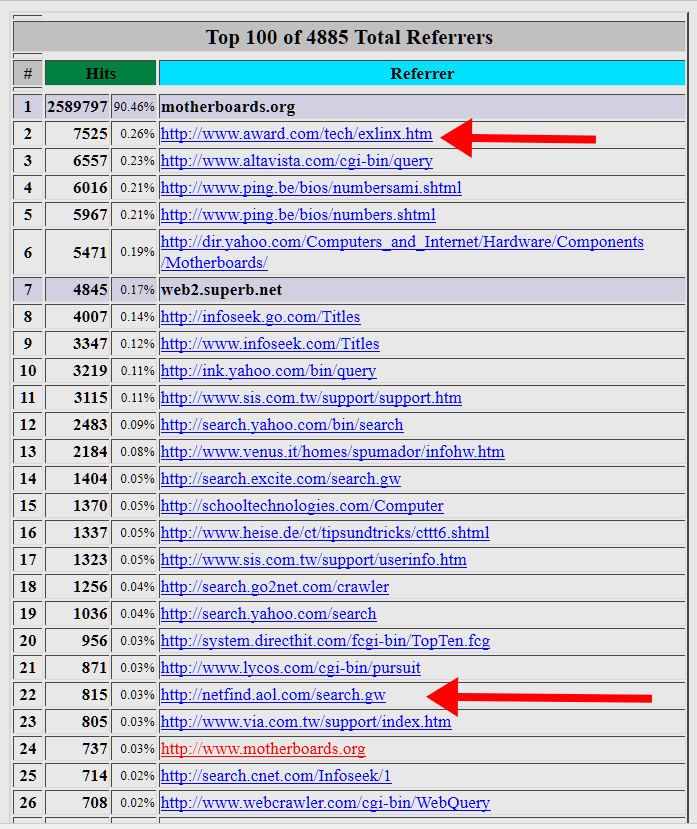
(Proof of enormous web traffic. Oh, and way to go 👏 AOL search engine. 💪 Not.)
And here's an archive of the web page that provided me with the highest quality inbound link. This comes from Award BIOS.
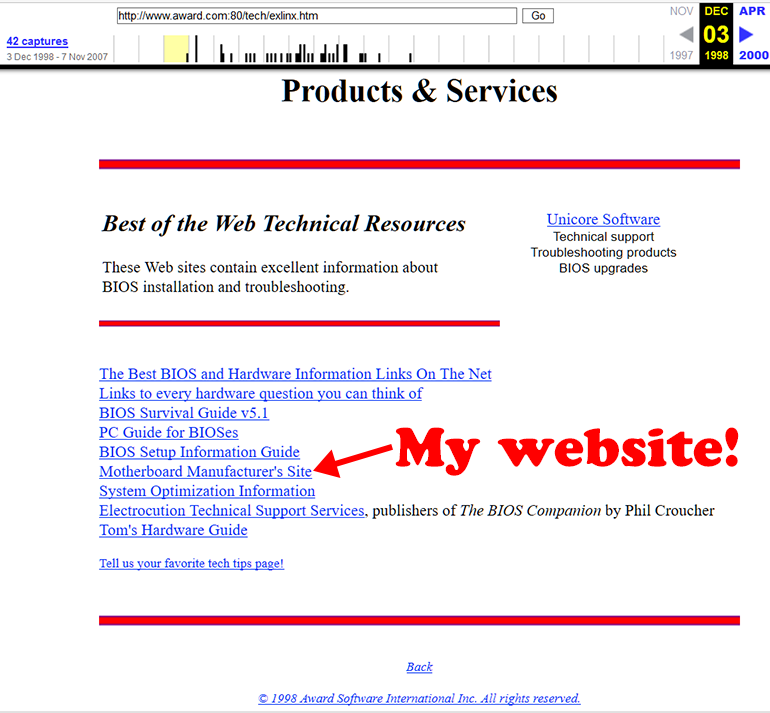
Proof that the Award Software website linked to my Manufacturer's page, which was my Number 1 external incoming link in January 1999. This is known as an organic link, because the people linking to my site decided on their own, "Hey, this is great content" and did so without my urging.
I am not going to bore you with the 1990s and turn-of-the century method for getting the search engines to find out about your site, and to get it listed. These methods have changed dramatically over the last 20 years, especially since the developers at Google came up with their Page Rank algorithm. In the 1990s, it was often a tedious process to "submit" your site to the search engines and waiting a month to get listed.
The Yahoo! Directory was a good place early on to get "curated" links. It got more and more difficult to add links later in the game as spammy websites cropped up. The early spammy websites, like the ones of today, were designed to have poor content and advertisements galore. This scourge is still rampant in 2017; however, the Google Page Rank algorithm is designed to counter them.
You will notice that the link that I submitted to the Yahoo! directory was doing pretty well, especially when you add it to the Yahoo! search engines (ink and search). I was possibly more thankful to Yahoo! than to the top search engine of the 90s, Alta Vista.
My advice 20 years ago and today is the same
Whatever you do on the web, generate good-quality, relevant, original content. This will get visitors, or in social media, this will translate into followers and likes and shares. The search engines and interest trackers will take note of this and promote it even more.
Translating Content into Dollars
As I have related up above, advertisements are one way to make money on your ideas and content. Starting in 1996, I delved into banner advertisements for making money on my website. Even today, this is a viable alternative to paywalls, product placement, and fake reviews. Even Steem is small-time compared to traditional banner ads! The main downsides to banner ads are that they are susceptible to blocking, they are distracting, and they only perform well if they are relevant to your content.In Part 4 I will discuss the specific techniques used for web advertisement in the 1990s. Here's the thing. The most important thing to know about ads is to connect your visitors and your target audience to relevant products and services. For my audience, this meant that motherboard retailers, memory manufacturers, and motherboard companies were interested in advertising on my site. My target audience consumed these relevant ads and were drawn towards my advertisers because they were actively seeking the advertised things in the first place.
My analogy is this. If your content attracts bears, you should offer them honey, too. They won't be able to resist the honey! Just make sure you are really attractive to the bears in the first place.
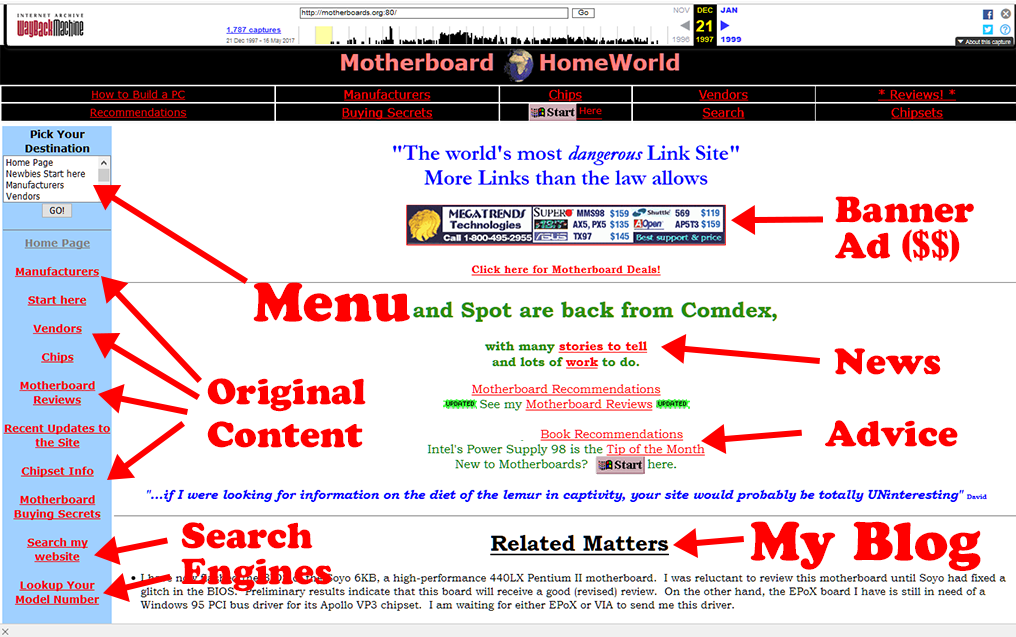
My website in 1997 (screenshot from Part 1)
Attracting your target audience
When I expanded my site, I had the best success when I wrote about related things. I have a wide-ranging knowledge and experience base. This is a bit of a problem for me, because my expertise is much more than just motherboards and computer hardware. I have still not entirely solved this problem. But in general, content-rich websites need to be fairly consistent with topics. So even though I like gardening, it's hard to imagine connecting this activity with computer hardware. Crossing over, expanding, and producing general interest content is much more difficult in my opinion. Please comment if you think otherwise!In 1997, I was taking great pains to produce motherboard content. I wrote a highly successful "How to Build a PC" article. Just as I am doing now, I broke it into separate parts. By doing so, this made advertisements able to be varied, and it allowed me to gauge how much interest visitors had in this particular content. Here in 2017, I will be monitoring my 5 part Introduction and see how my content generates interest in me.
You put the "U" in U R U I am ME (@uruiamme has meaning, don't U know?)
I sincerely hope it's not all about me, but about rich content, and the many yous who are reading this! I really mean that. I feel that sharing my story is not for showcasing me, but instead to actually help and interest you. Please follow me on Steem and find out for yourself.Back then, I was conscious of the many low-bandwidth users of my site. I even calculated once that 22% of my visitors turned off pictures in their web browser... they were so interested in the actual, meaty content about motherboards that were willing to forgo the media content. I knew why. If people had a dead or dying motherboard, they were more likely to be borrowing a slower computer or doing the bare minimum to find a replacement.
So I catered to those in foreign countries with poor Internet connectivity. People were still on dial-up modems and had to wait patiently for my content to appear. This focused my attention on fast, simple HTML and simple graphics. I shunned all of the extra glitzy content that would only slow everything down for many users. Most of this advice is almost unheard of now, but I can honestly tell you that not everyone has free, unlimited web access. And not everyone has the latest version of Windows or the latest browser or plug-in. I had to make my site for you and consider you in everything I did. U R U, and IamMe. @uruiamme
To summarize, my website had these focal points
- Anything about motherboard hardware
- Advice about what kind of PC hardware to buy
- Written content, not too much media content
- Simple, uncomplicated HTML
- Silly, nerdy, and humorous anecdotes
- Research tools for people to exit my site and find relevant sites (bye bye visitor)
And in Part 4, I discuss advertisers. A good advertisement is just a means for the visitor to exit my site to find a product or service. If the ad is a good one, the visitor will possibly be back for more.
The visitor who left my website is going to be highly likely to return if the first 5 elements are in place!
I even added to those 6 elements something not everyone can do:
7. Offer free support to people by posting my e-mail address on the Contact page.
In today's World Wide Web, this is not as satisfying. Most people would rather direct people to forums and community help platforms. This separates the website developer with the content creator. A true content creator will be more willing to help visitors directly, just as I did in 1996 to 1999.
Decline and Sale
After a few years of writing, coding, and maintaining the Motherboard HomeWorld, I was a bit burned out. The nice thing about the situation is that the money from ads kept rolling in. But there is a huge problem with web content and the World Wide Web in general. Things get stale.In the past 20 years, I have understood website design enough to know that the times change rather quickly. While if you are going to build an office building or retail store, architectural designs are essentially valid for 20 to 50 years or more. On the web, this cycle is about 2 to 5 years. If you don't revamp a website every 3 years with new design elements, you are going to fade into oblivion. There are some notable exceptions, but for most of us, this means expensive maintenance, upgrades, and fresh content all the time.
The underlying web server (and all of the applications that are used) will be updated for security reasons. The look and feel of the site will similarly need refreshing to compete with the new designs.
But I was never happy with any of the software I tried that generated "spaghetti" HTML code just to make the site look pretty. I resisted this. Not only would it have entailed a complete re-do of the site, it would have made me reliant on a particular kind of active server page (Microsoft and Cold Fusion were the dominant ones) and a particular editor. It would have completely isolated me from the simple design elements and (like tables and font colors) that I preferred to deal with directly.
Meanwhile, the content generation prowess that I had in 1997 waned a lot in 1998. I got burned out. Things were changing in my personal life, and the website became less and less appealing to my interests.
I began planning to move to another place where I would be less likely to have good Internet access. I wanted to start a new life. Followers of mine will discover that my new life consists of many interesting things, both in and out of technology and content creation. I'm excited.
So I began to look for a buyer. It just so happened that I had at least two interested parties. This was after my move to a rural area in 1999. After some email exchanges and phones calls to a man from the West Coast, I met up with an interesting man at an airport lounge to negotiate pricing. In 2 hours, I sold my website and had the check to prove it. The sale price was about the same as a year's worth of advertising dollars. It helped me start my new life in the country. (5 figure range.) I was particularly thankful to God for delivering me from the old and planting me into a new place, a place flowing with milk and honey.
And I am come down to deliver them out of the hand of the Egyptians, and to bring them up out of that land unto a good land and a large, unto a land flowing with milk and honey; - Exodus 3:8
I had sold out. Literally and figuratively.
In two and a half years, I had developed and sold a website that was based on my need for content. The Motherboard HomeWorld no longer exists on the web, but the website that took its place at motherboards.org has had a long run of success and failures that continued what I built.As you will see in a later episode, I was happy to be out of the website and Internet landscape. This latest stint on the web will be somewhat different. Modern web development tools are incredibly easier now. So if I can hereafter focus on the content more and less of the underlying structure, I am optimistic.
I think STEEM has a lot of advantages over 20-year old technology. The one-man band approach that I took is unlikely to be necessary any longer.
Please like this post and continue following my Introduction. If you want to know why I referenced "a land flowing with milk and honey," you will be surprised. More about that later, especially for my subscribers!
Now it's your turn
Follow me, follow me!! @uruiamme is my name. Please like this post and read the next Part. After my introduction, I will be moving on to other juicy topics!!Part 1: My Introduction and the value of content on the web
Part 2: [You are here] The development and success of the Motherboard HomeWorld, 1996 to 1999
Part 3: Search Engines before the dot-com bust
Part 4: Web Advertising before the dot-com bust
Part 5: Blogging before the term existed
#introduceyourself #history #technology #success #web
